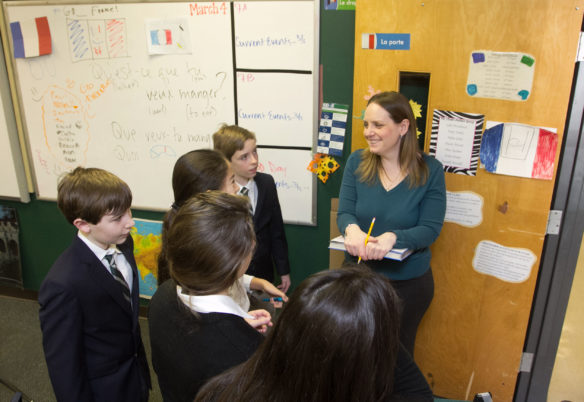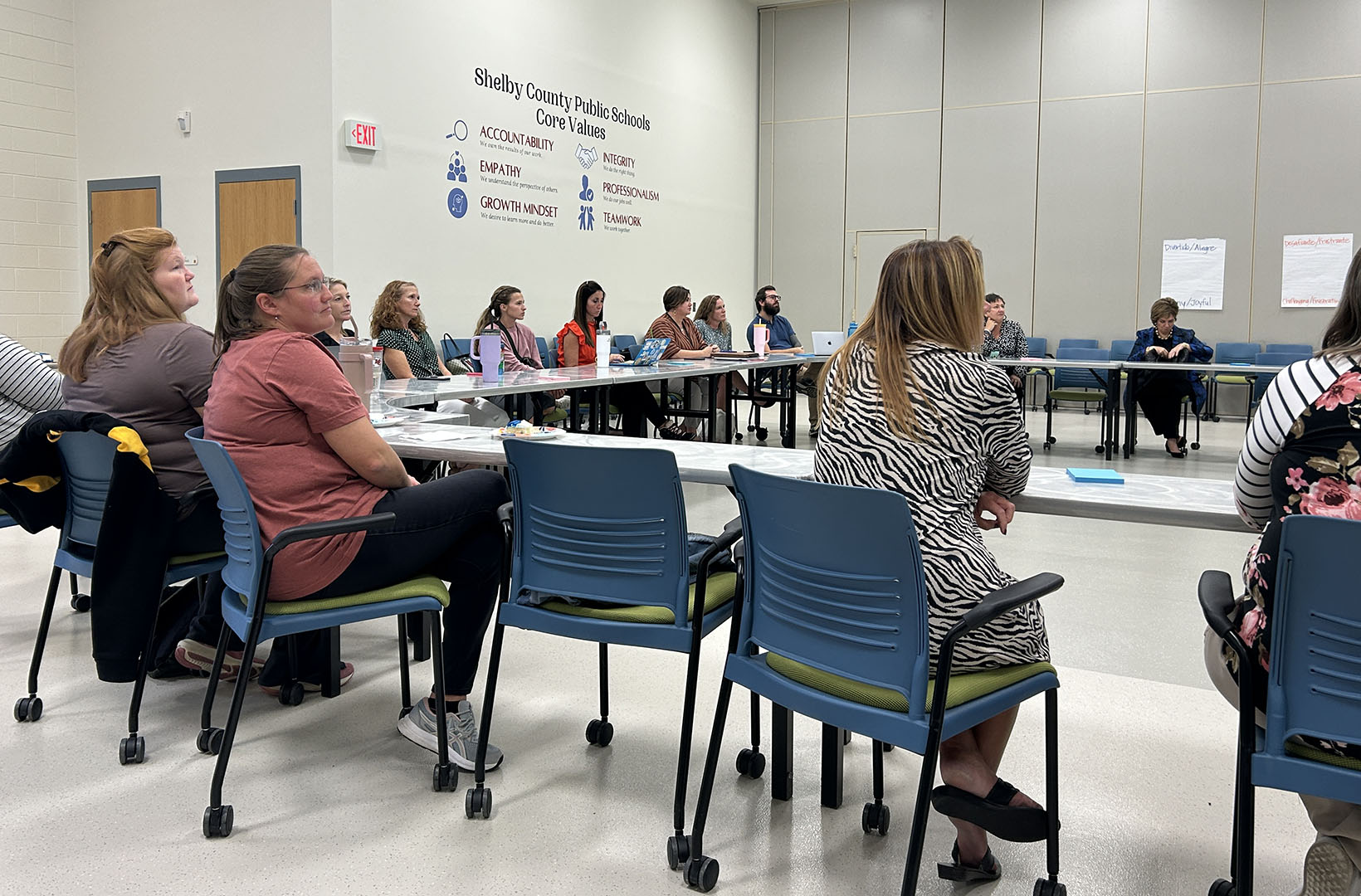This article is the second in a series of seven that focus on the core practices of world languages instruction. This series will try to open a window for world languages teachers, nontraditional world languages teachers and other educators as to what world languages education is about. The series will focus on two goals: to grow new leaders in the language learning profession, and to foster growth in students and teachers through effective instructional practices in language teaching.
Read the series:
- World languages: Strengthen your core!
- Core practices: Fostering interpersonal communication
- Core practices: Backward design of world language curriculum
- Core practices: Teach grammar as a concept and use it in context
- Core practices: Using authentic texts and resources
- Core practices: Provide feedback to improve learner performance

Sixth-grade students at The Lexington School complete an exit interview with teacher Sara Merideth before leaving class. Merideth says the goal of using a foreign language for 90 percent of classroom time, one of the Six Core Practices of American Council on the Teaching of Foreign Languages, shouldn’t scare educators.
Submitted photo by Mick Jeffries
By Sara Merideth
smerideth@thelexingtonschool.org
What’s in a number? (And how can one be so scary?)
Numbers make up a key part of our lives – our age, the day we got married, our children’s birthdays. These numbers all bring happy memories and thoughts of the future to mind.
Then, there are the numbers that strike fear into us – our weight, April 15 (aka Tax Day), and even the number 13. Yet, there is one number that language teachers across the nation fear more than anything else … the number 90.
It’s such a simple number by many standards, though for many it seems impossible. But now I’m getting ahead of myself; let’s back up to where this number came from and why it is so important.
As part of the Leadership Initiative for Language Learning (LILL) in the summer of 2015, I traveled to Columbus, Ohio, and gathered with 30 complete strangers who all had one goal in mind: to become a leader in the field of language education. We were from all over the country, representing various organizations who thought we had the chops to be leaders. What we learned, however, was that we were about to become students all over again.
We learned about, we reflected on and we practiced the Six Core Practices of American Council on the Teaching of Foreign Languages (ACTFL). These six practices are essential instructional practices that all teachers should be doing in their classrooms because they are powerful in advancing student learning. It was uncomfortable and it was fantastic!
The first core practice of ACTFL states that we should use the target language as the vehicle and content of instruction 90 percent of the time. The first part of the statement is one that every teacher can latch on to; we should be using the target language as the vehicle and content. It is the second part of that statement that makes it seem impossible.
As we move into an age where our students can learn a language on an app at their convenience, many of us have to prove our relevance. We are no longer teaching about a language, we are teaching our students to use the language. What better way to facilitate that use than to use the language ourselves?
The 90 percent number should not scare us; it should be a number that empowers us. That number isn’t just for teachers, it’s for students too. They should be trying to achieve use of the target language 90 percent of the time in your class as well. We have to remember that comprehensible output – or speaking the language to be understood – is just as important as comprehensible input, or the students understanding the language.
One of my favorite lessons learned from LILL was that of being a sympathetic interlocutor. What does this look like in the real world? It means having patience when someone is trying to communicate with you in a language that is not their own. It means helping them reach the meaning they are striving for without being terse or short with them. If we can do that with the common person on the street, why are we not doing it with our students?
If we want our students to produce the language, we have to help them negotiate meaning and we must be patient as they navigate their way through a conversation or even a sentence. Students need a license to make errors and they need to feel comfortable doing that in your classroom.
Are there challenges to reaching the 90 percent goal? Of course there are, but it doesn’t matter. You simply have to do it. You don’t have to do it overnight, but you do have to try a little more each and every day. So, how can this be done? What does it look like in your classroom?
Remember the following items to be successful:
- Create comprehensible language;
- Create context for the comprehension; and
- Create comprehensible interactions.
When creating comprehensible language for your students, remember to paraphrase any new words. Use vocabulary and structure they know and then build it over time by signaling new words or structures with the tone of your voice.
Remember this one caveat: never use the English translation as it undermines the acquisition of the language! The student knows not to try and negotiate the new word on their own because it will be defined if they just wait.
When creating context, be sure to use gestures and visual aids to help in comprehension. Another idea is to give them an advanced organizer so it will focus the students’ attention on the topic at hand.
When creating comprehensible interactions, be sure to involve the students through signaling or sentence cuing. You also can provide phrases for them to negotiate meaning, such as “Can you say more?” or “I think you’re saying … am I right?”
Also, consider these resources:
- ACTFL, The Language Educator – October 2012 – “Going for 90% Plus: How to Stay in the Target Language,” by Douglass Crouse (a French teacher at Sparta Middle School in Sparta, N.J.).
- Langtalks.org – Videos – “Scaffolding to Help Students Stay in the Target Language” by Lea Graner Kennedy (a French and Spanish teacher at Stonington High School in Pawcatuck, Conn.).
And remember this. The more you try, the better (and less scary) 90 percent will be.
Sara Merideth is the immediate past president of Kentucky World Language Association (KWLA) and the World Languages department chair at The Lexington School in Lexington. She is currently a French and world studies teacher for the school and serves as the Kentucky coordinator of Le Grand Concours National French Exam. In 2012, she was selected as the American Association for Teachers of French-KY French Teacher of the Year. She also represented KWLA as the Kentucky representative for ACTFL’s Leadership Initiative for Language Learning.



Leave A Comment